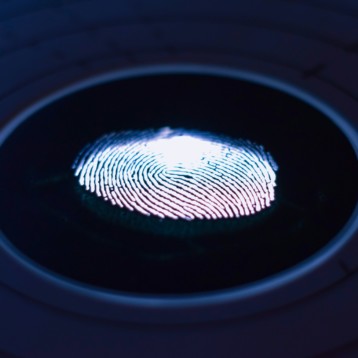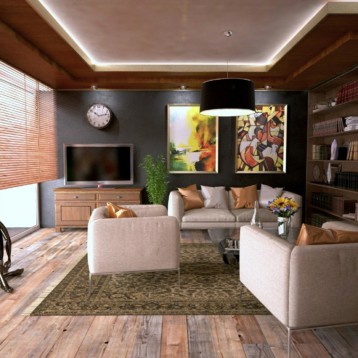For many years now, the Consumer Electronic Show (CES) held in Las Vegas, Nevada, has been the main place to hear about the next generation of consumer electronic technology. In recent years, the endless stream of product announcements at the show has become all but impossible to follow. For this reason, TFOT concentrated many of the most innovative products of this year’s show along with commentary based on our hands-on experience with the products to try to give a picture of how consumer electronics will look in the near future.
TFOT’s Most Innovative Technologies of CES 2008 by Category
TVs
 |
| Panasonic’s 150-inch plasma |
|
The area in which we saw the most innovation at CES 2008 was TVs. Starting with the introduction of Panasonic’s 150-inch plasma display, supporting advanced high-definition technology—or in layman terms, four times the resolution of current-generation full HDTVs (and in numbers, 4,096 by 2,160 pixels). This behemoth is the new king of large-screen TVs, and although no pricing and availability (or, frankly, little other details) were disclosed at CES, it likely that a few of these TVs will find their way into the market in a year or so, especially given the relative success of Panasonic’s 103-inch plasma that has already sold more than 3,000 units around the world since its introduction.
 |
| Samsung’s 82-inch Quad HD |
|
Panasonic was not alone when it came to ultra-HDTVs; Samsung also introduced an 82-inch Quad HD display—LCD, not plasma—with a slightly lower resolution than Panasonic’s 3,840 by 2,160 pixels. Westinghouse followed with an even “smaller” 56-inch LCD, which will be available for some $50,000 in spring 2008 according to the company. (Samsung did not disclose pricing or availability of its product.)
 |
Samsung’s 31-inch
organic LED (OLED) display |
|
One of the most stunning TVs on the showroom floor was located a few feet from Samsung’s Quad HD, display and it did not attract a lot of attention in terms of size. Samsung’s 31-inch organic LED (OLED) display was surely not the largest TV on at CES, but its image quality and colors were breathtaking. A unique effect that Samsung’s staff was aware of but could not explain was a strong feeling of depth when looking at the screen from certain angels. Sony, which is already selling the first consumer 11-inch OLED display, also introduced a prototype 27-inch OLED display that was appeared only 10mm thick, but large-scale production of sizable OLED TVs is not planned for 2008.
 |
| Philips’s $150,000 3D WOWzone wall |
|
Although Samsung’s OLED TV did display some depth at certain angles, the Philips 3D WOWzone multiscreen wall made us doubt our eyes as we gazed with awe at the 132-inch—nine attached 42-inch 3-D displays—full-HD image that displayed true 3-D movies; movies specially made for this medium could be watched without special glasses. Philips’s WOWzone is already available at $13,000 for one 42-inch 3D, full-HD display or $150,000 for the full WOWzone wall, which includes a computer.
Hands down, the most innovative TV technology on display at CES 2008 was Pioneer’s Project Kuro. Pioneer, the current leader in plasma technology, stunned even the experts when it showcased—in a small, closed, dark booth—a fully functioning prototype plasma technology that is 50 times better in terms of contrast than anything currently available on the market. Pioneer’s current line of high-end Kuro (“black” in Japanese) plasmas features a contrast ratio of 20,000:1, which is considered extremely high in this very competitive industry. The Project Kuro TV on display at CES 2008 had a contrast ratio of 1,000,000:1. No pictures of the new TV were released, nor we were allowed to take them ourselves, but a few pictures found their way to the Internet anyway. But trust us, no image can do this TV justice.
 |
| Pioneer Project Kuro – no pictures allowed |
|
In the darkened booth, the Project Kuro 50′ plasma TV, hidden under a curtain when we entered, was truly able to create dark color indistinguishable from the surrounding darkened room. The result was several scenes in which images appeared to float in midair. We want to stress that, in most normal scenes where large parts of the display were lit, the difference between the new Project Kuro and the existing high-end Kuro was less noticeable, but when this technology finally reaches the market, it will literally eliminate the dark-color issues that have existed for decades in the display industry. Pioneer did not specify a release date, but it will likely be more than a year from now.
Displays
When it came to computer displays, Dell dominated CES 2008 with several new products. SP2208WFP is Dell’s new 22-inch TN-based display with HDMI, DVI, and VGA video inputs; an integrated webcam; a 2ms, gray-to-gray response time; a contrast of 2000:1; 300-nit brightness; and 92-percent color-gamut CCFL backlighting. It does lack some of the ergonomics you can find on Dell’s other monitors, including vertical control and the ability to rotate into portrait mode. The SP2208WFP is already available at around $320.
 |
| DELL-3008WFP (Credit: Dell) |
|
In our view, the second display announcement by Dell was more interesting. The Dell 3008WFP is the new member of their 30-inch-display family, and it introduces several improvements over the already superb 3007WFP-HC. To start, Dell has finally solved the input issue lacking from its previous 30-inch line of models. Aside from the DVI (with HDCP, you can find HDMI, DisplayPort, Component, S-Video, VGA, and Composite connections). The 3008WFP also features 100 percent of the NTSC color gamut—up from 92 percent on the 3007WFP-HC—as well the tripled contrast of a whopping 3000:1 and a lower response time of 8ms (down from 12ms). The 3008WFP panel is still a high-end S-IPS, and the cost (if you can afford it) is just under $2,000.
Without argument, the most interesting computer display at CES 2008 was the Alienware (a wholly owned subsidiary of Dell) Curve 42.4-inch CRVD-42DWX monitor. This innovation is a deviation from the standard of LCD (and until several years ago, CRT) computer monitors. Instead, Alienware uses curved, triple digital-light processing (DLP) technology, developed by Texas Instruments for front and rear projection, together with LED illumination. This old-and-new technology makes for a deeper screen but it also reduces the response time of the display to about 0.02ms (or 100 times as fast as the most advanced LCD around). Other specifications are interesting, including a 10:000:1 contrast ratio, a declared NTSC color gamut of about 170 percent, and, of course, a native resolution of 2880 by 900 (the same as two 19-inch widescreens).
 |
| Alienware 42.4-inch CRVD-42DWX monitor |
|
Alienware is not the only one on the block to have a 42-inch curved DLP-based monitor. NEC has an almost identical creation, both developed by a small company called Ostendo Technologies. Prices for the new displays were not revealed, but reasonable speculation sets the price anywhere between $3,000 and $5,000.
The curved display debuted at CES 2008 is a prototype. Alienware’s display was running Crysis, and although the experience was truly breathtaking, we did notice problems that included distinct dividing lines between the areas in which the DLPs operate. We were not allowed to view the display using a normal Windows operating system, though Alienware assured us there isn’t any problem with the display. As for the lines on the display, Alienware says they should disappear by the time the display reaches the market sometime during the second half of 2008.
Video and Gaming Eyeglasses
 |
| TDVision 3-D stereoscopic video eyeglasses |
|
Several companies demonstrated video-eyeglass technologies. As we previously reported, the U.S. Company TDVision displayed 3-D stereoscopic video eyeglasses that can be used to play games as well as display 3-D animations and movies. From our experience with the prototype glasses at CES, the immersive experience was persuasive, and we found ourselves drawn more and more into the race-car world in front of our eyes. We didn’t like the design of the glasses, but this is expected from a prototype model, and we were promised that by the time the technology reaches the market later in 2008, the design will be improved considerably.
 |
| Myvu Crystal 701 |
|
Myvu also received a great deal of attention at CES for its video eyeglasses (also recently covered by TFOT). A U.S. company, Myvu already has a line of video eyewear on the market, and at CES they showcased their upcoming Crystal 701 model with VGA resolution and a fairly sleek look. After experiencing the glasses, we can report that they worked pretty much as you would expect, although the image did not seem to be as large as expected from this type of a device. Nonetheless, and given its competitive pricing, when the device reaches the market later in 2008, Myvu’s eyewear will be a hit for people who travel a lot by train or airplane.
 |
| Lumus see-through video eyeglasses |
|
Our CES 2008 video-eyewear pick goes to the Israeli company Lumus, which TFOT covered in depth in mid-2007. Since our preview, Lumus has improved the brightness of its see-through eyeglasses and changed the product look and feel, though they are still not as attractive as they should be. Lumus invested quite a bit in market research that suggested consumers would like see-through video eyeglasses to better keep in touch with their environment, but we still believe that, for the majority of users, better brightness and contrast is more important in the long run. On the other hand, making Lumus’s eyeglasses opaque is an easy task using a simple clip-on, so people can go either way.
Gaming Accessories
 |
| Dreamflyer in action |
|
CES 2008 was the home of several interesting gaming accessories, two of which caught our attention. The Canadian Company Flight Motion Simulators (FMS) showcased an innovative flight-simulator chair called Dreamflyer, which looked to us like a compact cockpit you can squeeze into your home. Besides the advanced joystick (a modified Saitek X52 Flight Control System throttle and pedals) that uses two USB connectors, the Dreamflyer uses no electricity for its operation. Instead, it captures motions based on simple gravitational movements of the chair initiated by the user in response to the views on the screen, thus eliminating the need for hydraulics and motors, and potential costly maintenance, reducing the price of the machine to $2,800 for the basic unit. Our flying skills will probably keep us away from Top Gun in the near future, but we were able to stay in the air long enough to feel how the chair functions when taking a hard turn or stalling the aircraft. Although not small and not that cheap, the Dreamflyer may be what some simulator fans have been dreamed about for so long.
 |
| TN Games vest |
|
One thing the Dreamflyer does not yet offer is the ability to feel the G-force that pushes your body when making tight turns. But this is not far from what was demonstrated by the Redmond, Washington-based company TN Games at CES 2008. TN Games debuted a gaming vest with eight pneumatic cells —four in front, and four in back—designed to simulate the direction and force of bullet fire in a first-person shooter (FPS) game. Completing the experience, TN Games also unveiled a helmet that has four pneumatic cells, giving you a “kick” every time are hit in the head. The entire thing is connected via USB to the computer and operates in real time with your FPS game.
We played with the vest and helmet for a while with a not up-to-date version of “Incursion,” which TN Games prepared demonstrate their technology. Our opinion of the vest is mixed—getting shot in the chest resulted in a very mild poke. TN Games explained that it is vital to match the size of the vest to the player in order to get the perfect feel. On the other hand, the helmet was probably more our size, and each shoot in the head felt like an actual punch; though not very strong, it is still not something you’ll want to repeat too much. The vest is already on sale for about $170, but the helmet will not reach the market until later in 2008. As for game support, TN Games’s website offers patches for several big titles, including Crysis, Half-Life 1 and 2, Medal of Honor Airborne, F.E.A.R., Enemy Territory Quake Wars, Quake 4, and Doom 3.
In the future, TN Games might offer a version of their technology that could be used for other types of games, and maybe such applications as flight simulators, complimenting other technologies like the Dreamflyer.
Computers
 |
| Dell XPS One |
|
Several new (and slightly less new) computers were shown at CES this year. Dell introduced its XPS One desktop with all its components embedded in a 20-inch display, which includes speakers and can doubles as a TV using an integrated tuner. Specialized companies, such as War Machine, showcased powerful gaming desktops, including the Nvidia 3-Way SLI and liquid cooling inside an all-black, full-tower case.
When it came to computers, the real deal at CES 2008 was laptops, and Fujitsu was one of the leading companies showcasing innovative light, portable laptops on the show. The Fujitsu LifeBook U810 features a 5.6-inch WSVGA touch-sensitive display, an Intel A110 processor, 1GB DDR2, and a 40GB (4200rpm) hard drive with WIFI B/G and BT; it weighs only 1.56 pounds (0.7 kilograms) and has HSDPA fast wireless-data-transfer technology in the form of two antennas on both sides of the screen, turning this ultraportable device into a real road warrior at around $1,000.
 |
Fujitsu’s LifeBook P8010 (left)
the new Fujitsu LifeBook U810 with HSDPA (right) |
|
A slightly larger, though still thin and light device from Fujitsu was the new LifeBook P8010. This 2.69lb (1.2kg) unit replaces the existing LifeBook P7230 notebook with a bigger display (12.1-inch WXGA, instead of 10.6-inch in the previous model); a more energy-efficient Intel SL7100 VL capable of powering the machine up to a whopping 6.5 hours with the supplied battery; as well as all the regular additions, including an 80GB hard drive, up to 4GB RAM, WIFI, BT, Firewire, three USB ports, a PC/SD card slot, and a 1.3-megapixel webcam. What is really special about this device is its Crystal View LED widescreen display. Side by side with anything else at the Fujitsu booth, this display was ultrabright and crystal clear. It should be available by spring 2008 for just under $1,700.
 |
| VIA ARTiGO Pico-ITX |
|
Going from small to smaller, VIA showcased two interesting form-factor computers. The first is the ARTiGO Pico-ITX, a DIY computer that includes a VIA VX700 Unified Digital Media IGP Chipset, 1 DDR2 533 SODIMM socket with up to 1GB of memory, and a VIA C7 1GHz processor. The ultrasmall case has four USB ports and a place for a 2.5-inch ATA hard drive as well as all the usual connectors (VGA, RJ45, microphone-in, and line-out). The entire unit measures 1.8 inches by 5.9 inches by 4.3 inches (4.5 centimeters by 15 centimeters by 11 centimeters) and weighs but 1.14 pounds (520 grams).
 |
| VIA MTube |
|
If you think the ARTiGO is small, how about a full computer that weighs only 0.33 pounds (150 grams), including a 2.8-inch, 640-by-480 resolution touchscreen? Well the upcoming VIA MTube is just such a device, and a working prototype was debuted a private meeting, with VIA running a 1GHz VIA processor, 256 megabytes of RAM, 8 gigabytes of flash (as HHD), Wimax, and Ethernet. The MTube we saw was running Linux (Ubuntu) and played YouTube videos. It will take several months until we see an MTube on the market, but these little gizmos could make a real revolution in ultraportable computing, having the horsepower of a UMPC with a size smaller than a Pocket PC.
Storage
 |
| Toshiba’s new hard drives |
|
Several new storage devices were on display at CES 2008. Toshiba announced 1.8-inch and 2.5-inch external storage devices in larger capacities and with a sleeker design. The 1.8-inch will be offered in capacities of 60 gigabytes, 80 gigabytes, and 120 gigabytes, and will include encryption and backup software. The larger 2.5-inch will go up to 320 gigabytes with a price of just under $200.
 |
| Crucial’s new 64GB SSD |
|
Crucial/Lexar Media demonstrated a 2.5-inch SSD 64GB storage kit for laptops and desktops, connected using USB 2.0 or a 3.5-inch drive bay bracket on desktops. The Crucial drive, called SK01, includes a SATA 3.0Gb/s hot-swappable drive bay and a 5.25-inch drive bay bracket. No price or read/write speed information were disclosed at CES.
SSDs were the big stars of the storage world at CES, and Toshiba demonstrated an interesting presentation at its booth showing two identical laptops, one with a conventional 2.5-inch hard drive and the other equipped with a Toshiba 64GB SSD. The two laptops were started at the same time and booted up through Windows Vista. The SSD-based laptop was significantly faster in booting the system—a few good seconds before its identical HHD-based brother.
 |
| Sandisk 72GB 1.8′ SSD |
|
At the Sandisk booth, the company showcased a new 1.8-inch SSD model with an unusual size: 72GB— the largest in the world in this form factor as far as we know. Sandisk was secretive about the exact specifications of the drive, and not much is known about its performance or price, although the company did claim to be faster than competing drives from Samsung (a claim we have yet to verify).
 |
| Sentry Group’s hard drive safe |
|
Rounding out the storage roundup at CES 2008 is a somewhat different innovation from Sentry Group, which together with Maxtor demonstrated a unique waterproof and fireproof safe that doubles as an external hard-drive safe that can be operated while remaining locked, protecting your data from potentially hostile environments.
Digital Photography
 |
| Casio EX-F1 |
|
This year, CES was not the launching pad for advanced digital cameras. However, one interesting camera we spotted was the Casio EX-F1, a camera that offers for the first time on the consumer level the capability to take 60 still images a second, as well as high-speed movie recording at 300 frames per second. We stopped by the Casio booth to take a quick look at the EX-F1 and were amazed by the ability to take movie-like still images of real-live action. The camera we were shown was preloaded with 7fps images (less than a quarter of the camera’s capability) showing a break-dancing act frame by frame. When this technology starts to reach a wider range of consumer digital cameras, we might witness a minirevolution in personal photography, as people will be able to capture real-time events without losing a second.
As for the Casio EX-F1 prototype itself, from our quick look we were less impressed with its hybrid between a DSLR and a Super-Zoom camera. With six megapixels and 12X optical zoom, it surely isn’t the most advanced Super-Zoom around; and as a DSLR, it will not allow you to replace the lens, which kind of takes the edge out of the DSLR title anyway. The price tag, however, is in the DSLR range at $999.
Digital Frames
 |
| Smartparts’s 32-inch SP3200 |
|
Digital frames could be seen all around CES this year, from sizes of a few centimeters up to large frames that could easily be hung on a wall. The largest we saw, and currently the largest in the world, is Smartparts’s 32-inch SP3200. This behemoth has a fairly high resolution at 1,366 by 768, and can display both images and videos (MPEG1, MPEG2, MPEG4, WMA, and AVI files). Such a size will set you back around $900.
Sound
 |
wide-screen-radio
(in the background Edifier Rainbow
wireless speakers) |
|
In terms of sound, CES was full of speakers of all shapes and sizes, from almost every important (and not-so-important) manufacturer on the planet. One major trend at CES this year was wireless sound, and several companies displayed supposedly high-end wireless speakers. Such a company was the Chinese manufacturer Edifier, which showcased several interesting designs for wireless infrared stereo speakers under the title Rainbow (tube-shape) and E3350 (pyramid-shape). Although its hard to truly judge sound quality at CES, we easily saw one downside of Edifier technology: relying on infrared, instead of RF, for example, requires line of sight, which isn’t always available and could be disturbed fairly easily.
 |
| Sonoro radios |
|
Another popular technology at CES this year was high-end radio/WIFI/iPod alarm-clock players. Edifier showcased several currently unnamed tabletop players, including one with a fairly large widescreen display for playing video, from a docked iPod. The second model does not have a screen but will have a CD for playing MP3s and regular CDs. Both devices will have HD radio, an SD card, and USB inputs built into it, as well as video-out for connecting them to a TV. Both should be released around July 2008, starting at around $300.
The German Company Sonoro showcased several new, sleek designs for advanced radios, including Cubo Elements, with WIFI/FM radio and an OLED-dimmable display; and Cubo Fusion, with a slot-in CD/MP3 player and an internal iPod rechargeable docking station.
 |
| Cue Acoustics r1 |
|
A third radio at CES was developed by the U.S. Company Cue Acoustics, and although it does not at this stage include WIFI or CD (though it does include an iPod dock), it has unique tactile technology. The r1 prototype had a tactile sensitive bottom that changed its movement according to how many stations were in close proximity to our current frequency. The same technology could also be applied to other settings such as volume, song selection, and so forth.
 |
| i-Fi home theater chair |
|
The most innovative sound-related technology we witnessed at CES 2008 was the i-Fi home theater in a chair. This device is a very large, comfortable, leather electric recliner equipped with embedded speakers and a subwoofer under the seat. The chair can be connected to a variety of sound sources, including an iPod (through a dock in the handle) or wirelessly to any audio source (including any decent home-theater system). The chair is controlled through several knobs on the handle that control the shaker and bass frequency. We were somewhat skeptical about this concept, having heard more than our fair share of home-theater systems, but from the moment we sat in the chair, we didn’t want to get up (and, no, it wasn’t just our CES-fatigued legs). The sound of the i-Fi feels as if it’s coming from inside your body. The directionality of the sound could not be compared to any home-theater sound system we are familiar with, including those that use $100,000 speaker systems. From our brief time in the chair, it was hard to judge the quality of the sound, but the general feel was truly breathtaking. The price for such a system is surprisingly not that high, around $2,500 not including shipping.
Cell Phones
 |
| Nokia N95 8GB |
|
CES is not the main cell phone exhibition in the world (this honor is reserved for the 3GSM convention in Barcelona, Spain), but several interesting cells phones did make an appearance nonetheless.
One of the first cell phones we played with was Nokia’s latest N95 8GB with a larger display (2.8 inches versus the original 2.6 inches), larger internal storage (8GB instead of the micro-SD slot on the previous model), and a supposedly improved battery (a major weakness of the previous model). The price ($780) and size still leaves something to be desired, but it seems like a worthy successor to Nokia’s flagship Smartphone.
 |
Toshiba G450 HSDPA
USB modem phone |
|
A strange-looking phone we briefly saw at the UTStarcom booth was Toshiba’s G450, HSDPA USB modem phone. This device is not only a mobile phone but also a USB modem, a USB data-storage device, and an mp3 player. It is designed to provide an easy way to link a laptop to the internet over a HSDPA mobile network and simultaneously make and receive calls. A unique feature of this device is its shape, or rather the shape of the keys, arranged in two circles creating an eight-like shape.
 |
| LG KU990 Viewty |
|
LG had several interesting mobile devices in its booth, the first being the LG KU990 Viewty, a sleek-looking 5MP equipped with a large 3-inch touch display. Although this isn’t a smartphone, the Viewty is a polished device with a simple touch-sensitive display and high-quality camera. One drawback, however, as with many similar devices, is that its finish seems to attract smudged fingerprints.
 |
| LG KS20 |
|
A second device at LG’s booth, the LG KS20, offered a wider range of features; this is a Windows Mobile 6.0 Professional phone powered by a 400MHz Qualcomm processor with 128 megabytes of RAM and 256 megabytes of ROM, plus a micro-SD slot. It comes equipped with WIFI b/g, BT 2.0, HDSPA, a 2MP camera, and a 2.8-inch touchscreen, with a stylus. We tested the KS20 and were mostly, and pleasantly, surprised by its small light structure. The display was somewhat dim, although it might merely have been the settings on the particular device.
 |
| LG watch-phone |
|
Just before we left the LG booth, we were in for a last-minute surprise: LG was showing an early prototype of a watch-phone. The LG representatives had very little information on the device, except to say that it’s indeed an early prototype; LG hasn’t decided whether this will go into production or stay as a proof-of-concept device. After seeing the phone display and UI, we are inclined to say that a watch better serves as a mediator between a fully functioning Smartphone and a BT headset, showing only the number, name, and possibly image of the caller—maybe even allowing simple functions like dialing a number from a phonebook. We’d leave multimedia and other more complex functions to a real Smartphone with a decent-sized display.
Another surprise was iRiver’s announcement that it is plans to enter the cell phone market. Its upcoming device is an iPhone-style device that, though less stylish, will include a 3-inch display with 480-by-272 resolution, a 2MP camera, 3 gigabytes, WIFI, BT, and a GPS receiver; it will also include 4 gigabytes of internal Flash memory and will be based on Linux.
At the MIO booth, we had a chance to see the new A702, the much-anticipated successor to the A701. This quad-band/EDGE Windows Mobile 6.0 device has many interesting features including WIFI b/g, BT, GPS, a 3.2MP camera, a numerical keypad and touch-sensitive screen (together with a stylus), and a fairly powerful battery (1130mAH). On the downside, the screen is just 2.7 inches, mainly due to the keypad, and the processor is a potentially sluggish 200 MHz (TI OMAP 850) with only 64 megabytes of RAM.
 |
| MIO two-sided hybrid cell phone/PDA/GPS |
|
MIO also introduced a device that didn’t yet have a name. This new device is an interesting hybrid cell phone/PDA/GPS, where instead of combining the two, one side of the device is a dedicated cell phone with a small screen and a keypad and the other is a fully functioning PDA. The idea is very interesting, and anybody who has ever used a smartphone (especially one that is WM-based) can tell you that the stability of these devices falls far short of a dedicated old-fashioned cell phone, so separating the two but keeping them in one device is not a bad idea. However, we didn’t really like the design of this prototype, especially the very small display, although we are probably spoiled by all the 3-inch touchscreens floating around. Hopefully by the time this device reaches the market, the device will have undergone some refinements.
 |
| Neonode N2 |
|
One of the most pleasant surprises when it came to cell phone at CES 2008 was from the Swedish company Neonode. The company showcased their upcoming N2 phone, which is based on Windows CE 6.0 (no Windows Mobile, although from what we were told, they are considering it). The N2 is tiny (about 2.1 ounces, or 60 grams) and has a small-but-clear 2-inch display with a 176-by-220 resolution. Besides its sleek design, a unique feature of the N2 is its interface, based on a proprietary technology called zForce, that is an optical touchscreen that doesn’t require hard pressure or a stylus. It reacts to sweeping and tapping signals on the screen, and a user can easily navigate through the menus by looking at the arrow signs on the sides of each page. The N2 is in some respects a tiny version of an iPhone (Neonode’s words, not ours), and the company is also thinking about a next-generation device with the same technology and a larger display.
 |
| Sony Mylo2 (Credit: Sony) |
|
Somewhere between the realm of the smartphone and that of Ultra Mobile PC (UMPC), a new kind of device category emerged at CES 2008. Mobile Internet Devices (MIDs) are small and simple devices oriented toward Internet and e-mail applications. They will be considerably cheaper than comparable UMPCs (in the sub-$500 range) and will have a different target audience. MID is in many respects an Intel initiative that is trying to push a new generation of ultralow-power devices into the market. This year at CES, several companies showcased MID devices, including Sony, which displayed the Mylo2, a PSP-style device with a touch-sensitive 3.5-inch, 800-by-480 display (actually too small for many of today’s websites without sideways scrolling) that uses WIFI for connectivity (no 3G). It does support Skype and has a camera (no BT). Working with heavy websites is reportedly not that fast, and it will probably be a while before a truly capable MID device appears on the market at a reasonable cost.
Gadgets
 |
| Nokia’s MD-7W Bluetooth Speakers |
|
As the world’s most important consumer-electronics show, the exhibit was packed with cool, not-so-cool, and even utterly bizarre gadgets of all shapes and sizes. It’s all but impossible to cover everything at CES, but here is a rundown of the more interesting stuff we came across and haven’t covered in previous sections.
 |
| Nokia Eco Sensor Concept |
|
At Nokia’s booth, we found brand-new, magnetic MD-7W Bluetooth Speakers, as well as two new BT headsets named BH-102 and BH-210 (both BT 2.0 with EDR, but not much else). We also had our chance to see the rather bizarre-looking Nokia Eco Sensor Concept for the first time on display.
 |
Sennheiser’s MX W1
Wireless stereo earphones |
|
Sennheiser showcased at CES its new MX W1 Wireless stereo earphones that should be available May 2008. The MX W1 do not use BT technology, like you would expect but instead utilizes a proprietary RF-technology developed by the semiconductor company kleer. The technology uses less power and will probably be better suited to transmit sound than BT, but you will need a special transmitter to use them with your iPod or Zune. Each transmitter can send information to two pairs of wireless earpieces, which is a nice feature. Another amazingly useful feature is Sennheiser’s twist-to-fit design: above each earpiece, Sennheiser has added a small plastic thingy that fixes the earpiece in your ear. We were skeptical, but Sennheiser gave us a pair to try, and though we tried hard to dislodge the earpieces, they remained firmly locked in our ears (even shaking our heads from side to side didn’t nudge these little fellows). We felt that the design of the earpieces was very attractive, however, unlike using a BT headset on one ear, using the MX W1 on both ears was somewhat geeky looking. On the upside, the rated battery life of the two earpieces (with 400 mAh Li-ion battery in each of them) is approximately 10 hours between recharges. On the downside, you are looking at a price tag of about $600.
 |
| ATP’s GPS Photo Finder |
|
A slight variation on a concept we already saw at CeBIT 2007 for GPS-cameras was also on display at CES 2008, this time from the Taiwanese Company ATP. The GPS Photo Finder is compatible with any digital camera and allows one to easily find the location in which a picture was taken by tagging photos with GPS coordinates, providing a convenient way to track your trips with Google Earth and other applications.
 |
| Quik Pod |
|
Another camera-related accessory on display at CES was Quik Pod, a small, extendable handheld tripod. The U.S. Company Fromm Works created the two Quik Pod models displayed: a short model to be used with most point-and-shoot cameras to take pictures of yourself, and a longer one that can be used as a mono-Pod for more serious photography work.
 |
| Pinnacle’s Video-Transfer |
|
On to a video-related innovation, Pinnacle showcased its new Video-Transfer device that can convert almost any type of video into digital form and save it as a file on a mass storage device, such as a video iPod, PSP, flash drive, or hard drive, without the need of a computer or complex conversion software. This device could be a good and simple way to convert old VHS tapes into digital media without much hassle, and even convert TV directly to your iPod. We liked this device’s simplicity; however, it comes at a cost, as there is not a display and all the actions are performed using one-touch bottom.
 |
| Creative inPerson |
|
At CES 2008, Creative displayed for the first time its inPerson portable videoconferencing device. The inPerson is a small portable device with a 7-inch widescreen LCD, a tiny 76-inch wide-angled lens, and a 640-by-480 resolution (with a promised “excellent low-light capability”). The inPerson can connect to the Web using either WIFI b/g or an Ethernet connection and has a researchable Li-ion battery and echo-cancellation technology. Creative plans to market this device for businesspeople who will use it for video conferencing with a similar device, or with an online Creative service. Sadly, Creative will not market the device as an open platform that can use Skype or other voice-video solutions; the price is also an issue—just under $700—not a surprise when this device is aimed at the business sector. From our experience, the video quality of the inPerson at CES left something to be desired, but in all fairness, the lighting conditions were also fairly bad.
 |
| eCoupled Wireless Power |
|
One of the truly inspiring technologies of CES 2008 is Fulton Innovation’s eCoupled Intelligent Wireless Power. Like several other upcoming charging pads, as well as with some electrical toothbrushes, eCoupled technology is based on the principle of inductive coupling, a process by which energy is transferred from one circuit component to another through a shared magnetic field. This type of power transmission isn’t limited to physically connected devices, since the change in the current flow of one device is caused by the influence of the other device on the magnetic field between them.
What is interesting and truly innovative about eCoupled’s is its vision of how its smart inductive technology can work. Instead of merely thinking small, creating a charging pad for a particular cell phone, MP3 player, or camera, eCoupled’s technology allows close, 2-centimeter range wireless transfer of electricity from milliwatts to kilowatts. eCoupled demonstrated at CES the charging of laptops, lightbulbs, and even electric frying pans. Truly futuristic was a seemingly regular table embedded with eCoupled’s technology, which can wirelessly charge any compatible device placed on top of it (equipped with eCoupled’s technology, of course).
Another interesting innovation, although not that new, Yoggie, a hardware-based security system for a PC. The system is based on USB key–sized security minicomputer that can connect to any PC or laptop and runs all basic security applications, including anti-virus (Kaspersky), anti-spyware (Kaspersky), firewall, content security (SurfControl plc), and digital certificates (VeriSign). The Yoggie Gatekeeper Pico USB device contains a 520MHz CPU and 128 megabytes of RAM—a fairly powerful specification for a dedicated Linux device. The unit connects to any computer and works by redirecting all network traffic to the computer through the Gatekeeper Pico before it reaches the PC. A big advantage of the Gatekeeper Pico is the fact that the main CPU of the computer is left clean without the need to handle resource-hungry applications such as anti-virus. The Gatekeeper Pico checks for updates every few minutes but otherwise sits fairly unobtrusively in the background.
 |
| i-Buddy |
|
CES is not only about serious technology. Many fun and new innovations were also on show at the exhibition this year. One of them, named i-Buddy, was developed by a small Taiwanese company. The i-Buddy is a small USB-powered figurine that is controlled by the emoticons sent via Microsoft’s MSN Messenger software. An angry emoticon sent your way will cause your figurine to glow red, while a smile will cause it to change colors and flap its wings. All in all, the idea isn’t half bad (especially as a gift for a teenager that spends half of her waking hours talking to her friends on MSN Messenger), but the implementation does need some improvements, and there are many potential additions and variations that can be created to improve the basic design.
 |
| iShoes |
|
One of the last things we had a chance to see at CES 2008 was the iShoes, a new type of personal transportation and recreational gadget. The device looks like oversized shoes with three wheels and is powered by an electric motor that lets the wearer reach a speed of 15 to 20 miles an hour. The speed is controlled by a small handheld devices, connected, sadly, by a cable to one of the shoes. The second shoe has no motor and is worn for balance. The iShoes do not have brakes, but from the demonstration we received from the developer, Ilya Kaganovich, stopping seems quite intuitive (although we didn’t have a chance to test it ourselves). The iShoes have a range of about 3 miles, and although they can’t be a real substitute for Segway, or even a bike, they might still be fun to use if you are willing to spend $600 on such a gadget.






















































